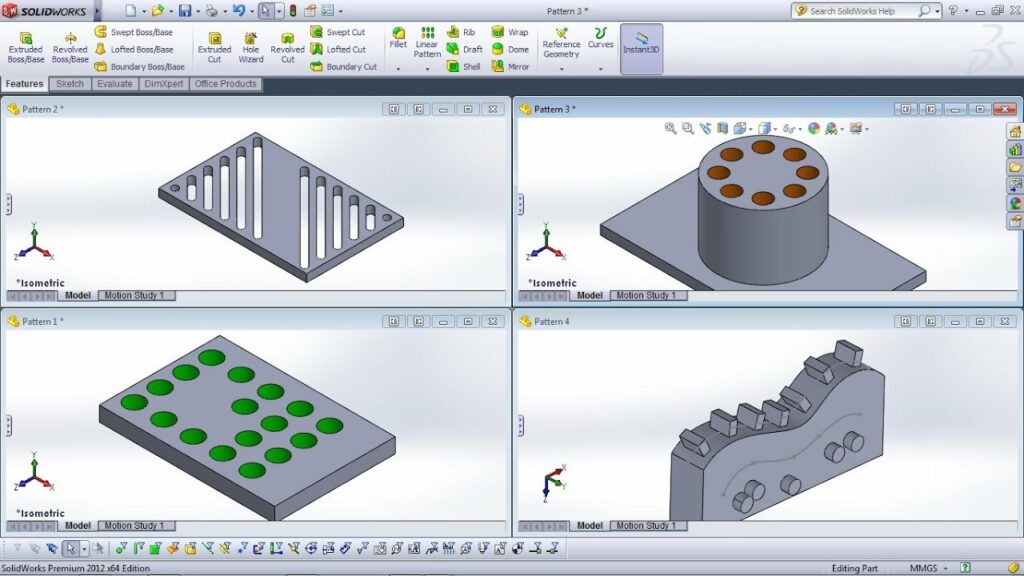Mastering Feature Patterning in SolidWorks: A Comprehensive Guide

Introduction: SolidWorks, a leading computer-aided design (CAD) software, provides engineers and designers with powerful tools to create complex and precise 3D models. Among its diverse array of features, patterning stands out as a versatile tool for replicating and arranging features across parts and assemblies. In this comprehensive guide, we’ll explore the intricacies of patterning features in SolidWorks, covering fundamental concepts, essential techniques, and advanced strategies to help you master this versatile tool.
Understanding Feature Patterning in SolidWorks: Feature patterning in SolidWorks involves replicating one or more features across a defined direction or pattern. Patterning is commonly used to create arrays of features, such as holes, fillets, or extrusions, to achieve symmetrical designs, enhance productivity, and reduce modeling time. Before delving into the specifics of patterning features, it’s crucial to grasp some foundational concepts:
- Sketching and Features:
- Sketching forms the foundation of design in SolidWorks, allowing users to create 2D profiles that define the geometry of parts and features. Features are built upon sketches and represent operations such as extrusions, cuts, fillets, and more.
- Patterning Direction and Type:
- Patterning in SolidWorks can be linear, circular, or sketch-driven, depending on the desired pattern direction and arrangement. Linear patterns replicate features along a linear path, circular patterns replicate features around a circular axis, and sketch-driven patterns replicate features based on a user-defined sketch.
- Pattern Instances and Spacing:
- Pattern instances refer to the number of copies or repetitions of a feature within a pattern. Users can specify parameters such as spacing, distance, and orientation to control the arrangement and distribution of pattern instances.
Patterning Features in SolidWorks: SolidWorks offers multiple methods for patterning features, each suited to different design requirements and preferences. Let’s explore the essential tools and techniques for patterning features:
- Linear Pattern:
- The Linear Pattern tool is the primary method for replicating features along a linear path in SolidWorks. Users can access the Linear Pattern tool from the Features tab and select the feature to be patterned, the direction of the pattern, and the desired number of instances. SolidWorks then creates a linear array of pattern instances based on the specified parameters.
- Circular Pattern:
- The Circular Pattern tool replicates features around a circular axis in SolidWorks. Users can access the Circular Pattern tool from the Features tab and select the feature to be patterned, the axis of rotation, and the desired number of instances. SolidWorks then creates a circular array of pattern instances based on the specified parameters.
- Sketch-Driven Pattern:
- The Sketch-Driven Pattern tool allows users to replicate features based on a user-defined sketch in SolidWorks. Users can access the Sketch-Driven Pattern tool from the Features tab and select the feature to be patterned, the sketch to define the pattern, and the desired number of instances. SolidWorks then creates a pattern based on the geometry of the selected sketch.
Advanced Patterning Techniques: In addition to basic patterning tools, SolidWorks offers advanced techniques to enhance patterning workflows and achieve precise design objectives:
- Variable Patterns:
- SolidWorks allows users to create patterns with varying parameters, such as spacing, orientation, and instance count, using the Variable Pattern tool. This tool provides greater flexibility and control over the arrangement and distribution of pattern instances.
- Pattern Seed Features:
- Pattern Seed Features enable users to pattern features based on a reference feature or set of features in SolidWorks. By selecting a seed feature, users can replicate its geometry and parameters across the pattern, ensuring consistency and efficiency in design.
- Geometry Pattern:
- The Geometry Pattern tool replicates features based on existing geometry within the model in SolidWorks. Users can select reference geometry, such as edges, faces, or vertices, to define the pattern, and SolidWorks automatically generates pattern instances based on the selected geometry.
Best Practices for Feature Patterning: To maximize efficiency and maintain design integrity when patterning features in SolidWorks, it’s essential to adhere to best practices:
- Design Intent:
- Consider the functional requirements and aesthetic preferences of your design when patterning features. Design with symmetry in mind, ensuring that patterned features align with design intent and maintain consistency across the model.
- Pattern Direction and Orientation:
- Carefully select the pattern direction and orientation to achieve the desired arrangement and distribution of pattern instances. Consider factors such as part geometry, assembly constraints, and manufacturing considerations when defining pattern parameters.
- Instance Count and Spacing:
- Determine the appropriate number of pattern instances and spacing to achieve the desired density and coverage of patterned features. Balance between sufficient coverage for design requirements and optimization for performance and efficiency.
- Validation and Testing:
- Regularly test and validate patterned features to ensure that they meet design requirements and performance expectations. Use tools like interference detection, simulation, and physical testing to identify and resolve any discrepancies or errors.
Conclusion: Feature patterning is a versatile tool in SolidWorks, enabling engineers and designers to replicate and arrange features efficiently and accurately. By mastering the tools and techniques for patterning features, you can enhance your design capabilities, streamline your workflow, and produce high-quality models that meet design requirements and manufacturing standards. Whether you’re a novice or an experienced SolidWorks user, understanding the principles of feature patterning and applying best practices will elevate your design proficiency and enable you to realize your design visions with precision and efficiency.




